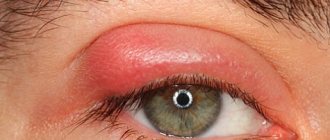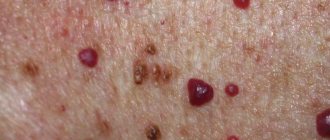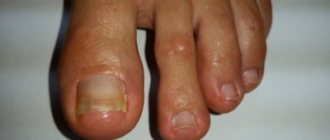A stye
is a swelling on the eyelid, usually with a white or yellow pus-filled head. From a medical point of view, barley is an acute purulent inflammation of the hair follicle of the eyelash or the mouth of the sebaceous gland.
Barley is a popular name, but when a doctor makes a diagnosis, he will write it as hordeolum .
There are external and internal barley. External stye
- This is a classic situation when the stye is on the outside of the eyelid.
Internal stye
is located on the mucous membrane of the eyelid; in this case, a lobe of the meibomian gland (the fatty gland of the cartilaginous plate of the eyelid) becomes inflamed.
Causes of stye
In most cases (up to 90%), the causative agent of the disease is Staphylococcus aureus. You can get an infection by simply rubbing your eyes with dirty hands. However, in order for barley to occur, the penetration of infection alone is not enough; it is necessary that the body’s defenses cannot cope with it. As a rule, barley develops in conditions of weakened immunity (for example, after a serious illness). A depressed state of immunity can also be a consequence of helminthic infection, as well as exposure to factors such as vitamin deficiency, hypothermia, lack of sleep, stress, etc. If stye occurs frequently (more than once), it is necessary to undergo a comprehensive medical examination. Perhaps in this case, barley is a manifestation of diabetes. Barley can also occur against the background of diseases that have a similar localization - inflammation of the tonsils (tonsillitis), sinusitis (sinusitis or sinusitis), dental diseases. Eye diseases - blepharitis (inflammation of the edge of the eyelid), demodicosis (infection with eyelash mites - demodex), conjunctivitis - can also contribute to the development of stye.
What causes inflammation?
The reasons that cause inflammation are mainly associated with non-compliance with simple hygiene rules: using someone else's cosmetics, not washing off cosmetics before bed, dirty hands used to wipe the eyes, getting staphylococcus into the eye. But it happens that stye on the eye is provoked by the demodex eye mite. It is located near the root of the eyelash or eyebrow. The cause of the disease may also be hidden under concomitant diseases: diabetes mellitus, helminthic disease, reduced immunity, problems with the gastrointestinal tract. It is the constant nature of the occurrence of the disease that indicates a concomitant illness. Therefore, it is she who will have to be treated. If you cannot quickly cure a stye and another one immediately forms in place of the old one, then you should consult a dermatologist, since the cause of inflammation can be blepharitis or conjunctivitis. Wikipedia states that among the main causes of the disease there is a period of decreased immunity during colds. But the list of reasons also includes periods after operations, stressful or depressive states, physical and nervous exhaustion, and anemia.
Symptoms of stye
The appearance of stye begins with the appearance of itching, usually localized at a point on the edge of the eyelid. Then the skin in this place begins to turn red, swelling forms, and the eyelid swells. Painful sensations occur, which intensify if you touch or press on the sore spot. In some cases, stye prevents the eyelid from closing completely. The eye may become very watery. The parotid or submandibular lymph nodes are enlarged. The temperature may rise.
On the 2-3rd day, a white or yellowish head forms at the top of the barley. After some time, the barley “ripens” and breaks through. Pus flows out. After which the eye gradually returns to normal.
Diagnosis and treatment of lumps on the eyelid
Only an ophthalmologist can determine the true cause and type of seal on the eyelid during a consultation or diagnostic examination. Treatment of the tumor is selected individually in each case and can be carried out both with medication and surgery.
As you can see, there are many reasons for the appearance and types of neoplasms on the eyes, so only a specialist can determine their “nature”. The Eye Clinic of Dr. Belikova employs experienced doctors and uses modern equipment, which allows an accurate diagnosis to be made as quickly as possible, as well as the most effective manipulations.
Treatment methods for stye
Under no circumstances should you squeeze out the head of barley. It's really dangerous. When squeezed out, pus can enter the blood vessels and cause cellulitis of the orbit or thrombosis of the veins of the eye. There is also a risk that, moving along with the flow of venous blood, infected particles of pus will enter the cranial cavity and cause thrombosis of the cavernous sinus of the brain or meningitis.
If the stye is treated immediately, it is possible to avoid the appearance of a purulent head. At this stage, cauterization with alcohol, brilliant green, and dry heat are used. If the head does appear, you can no longer heat the stye, otherwise the suppuration will only intensify. Antibacterial ointments are also used, but such drugs must be prescribed by a doctor.
After the abscess breaks through, it is important to cleanse the skin of the eyelids from purulent discharge and dry crusts. Until the skin at the site of the stye is completely restored, you should not use makeup - this can lead to complications.
When to see a doctor
You should definitely consult a doctor:
- if the appearance of barley is accompanied by an increase in temperature;
- if stye presses on the eye. In this case, they usually complain that the eye hurts. There may also be a headache;
- if barley persists for more than 5 days;
- if several barley appears at the same time, or if after the disappearance of one barley, a new one appears;
- when conjunctivitis occurs (inflammation of the mucous membrane of the eye).
Regarding the treatment of stye, you should consult an ophthalmologist or surgeon. Doctors at the clinics of JSC “Family Doctor” will help you correctly understand the diagnosis, as well as cure barley at an early stage without any complications.
Make an appointment Do not self-medicate. Contact our specialists who will correctly diagnose and prescribe treatment.
Rate how useful the material was
thank you for rating
How to cure inflammation?
It is impossible to cure stye on the eye with one magic remedy. But you can significantly speed up the process of releasing pus. To do this, on the first day of illness, wiping the itchy area of the eyelid is prescribed. Treatment consists of the drying effect of iodine, brilliant green solution or medical alcohol. This procedure is repeated several times during the day. The disease at this stage will require the use of eye drops and ointments. Drops are used several times a day. Tobrex, chloramphenicol or tsipromed are suitable for this. Tetracycline or hydrocortisone ointments are placed behind the eyelid while you sleep. Treatment will be significantly accelerated if you take a UHF course, but only after consultation with your doctor. Under no circumstances should you try to cure stye by warming your eyes at home. A stye on the eye will go away faster if you follow a cleansing diet and eat plenty of vitamins and fruits. This will boost immunity and give the body strength to fight infections. It is more difficult to cure a stye in a child’s eye, because he will constantly rub his eyes with his hands, thereby introducing an infection there. Moreover, the eyelid in children swells so much that the eye almost completely closes. Treatment must be prescribed by a doctor, since adult medications are not suitable for children. They are usually prescribed drops of albucid and sulfonamides internally. Always follow the dosage, which should be appropriate for the child's age.
Early symptoms
When the inflammatory process in the area of the hair follicles has just begun to form, the disease is characterized by the following clinical symptoms:
- redness in the affected area;
- compaction on the skin;
- slight tissue swelling;
- sensation of a foreign body under the eyelids;
- itching, burning, pain in the affected area;
- redness of the eyes;
- increased production of tear fluid.
After passing the initial stage, compaction begins in the lesion. This means that pus has been released in large quantities and has accumulated under the skin.
Stages of the disease
There are several stages in the development of the disease:
- Infiltration. A small bump appears on the inner or outer surface of the eyelid, which can easily be confused with a speck that has gotten into the eye. In this area, itching, redness, and slight swelling occur, which intensify over time.
- Suppuration. After some time, the swelling increases, fills with pus and causes serious discomfort when touched or blinked.
- Breakthrough of the abscess. In the normal course of the disease, after 3-4 days the abscess ripens and ruptures itself, the contents coming out to the surface of the skin. if this does not happen, the purulent capsule will have to be opened surgically in the doctor’s office.
- Healing. The affected area ceases to be painful, the wound heals, a crust forms, which falls off over the next few days, revealing healthy tissue.
Diagnostics
Due to the fact that the foci of inflammation are superficial (except for ulcers in the ear), it is not difficult to diagnose furunculosis. However, with long-term, treatment-resistant furunculosis, there may be a need for extensive diagnostics to establish the exact causes of the disease. In this case, immunodiagnostics, a detailed blood test are performed, and the boil is examined for bacterial seeding of the purulent contents. If the study does not produce results, it is necessary to do a full examination of the body, since furunculosis may be the result of some general disease (blood disease, diabetes, etc.).
Prevention
To prevent the development of the disease, preventive measures must be followed. You cannot use someone else’s cosmetics and hygiene items. After a walk, you should wash your face and hands.
A good prevention of eye suppuration is taking vitamin complexes and timely treatment of ARVI. You also need to visit an ophthalmologist 1-2 times a year for a preventive examination.
You can make an appointment with a doctor at the Santa Clinic in Chelyabinsk. Just call and choose a convenient time to visit.
Types of boils
Depending on the stage of development, boils are divided into several categories:
- the onset of the inflammatory process, which manifests itself as slight redness in the affected area;
- acute inflammatory process with the formation of a large amount of pus under the skin;
- full maturation, when the pus is located close to the surface of the skin;
- skin damage and pus coming out.
Based on the number of formations, the disease is divided into several groups:
- single formation, localized only at one point;
- the appearance of multiple boils along the hairline.
Depending on the location of the purulent discharge, boils are divided into several types:
- superficial, when purulent discharge is localized only in the hair follicle;
- deep, characterized by decay of the deep layers of the skin.
In the medical history, the doctor describes the type of boil and subsequent treatment.
Complications
If left untreated, the patient may experience the following complications after the formation of a boil:
- penetration of pus into the deep layers of the skin;
- an increase in the number of boils on the eyelids and eyebrows;
- spread of the infectious-inflammatory process to the conjunctiva, cornea, lacrimal sac;
- severe swelling of the eyelids, when the eyeball is practically invisible;
- chronic infectious and inflammatory diseases in the hair follicles of the eyelashes and other areas of the eyes.
To prevent complications, it is recommended to begin therapy immediately after swelling and slight redness appear on the eyelids.










